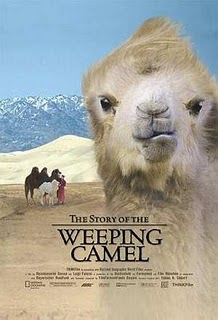The Story of the Weeping Camel
| The Story of the Weeping Camel Ингэн нулимс |
|
|---|---|
 |
|
| Directed by |
Byambasuren Davaa Luigi Falorni |
| Produced by | Tobias Siebert |
| Written by | Byambasuren Davaa Luigi Falorni |
| Starring | Janchiv Ayurzana Chimed Ohin |
| Music by | Marcel Leniz Marc Riedinger Choigiw Sangidorj |
| Cinematography | Luigi Falorni |
| Edited by | Anja Pohl |
|
Production
company |
Mongolkina
|
| Distributed by | Prokino Filmverlieh (Germany) New Yorker Films ThinkFilm (US) |
|
Release date
|
|
|
Running time
|
87 minutes |
| Country | Germany Mongolia |
| Language | Mongolian |
| Box office | $9,328,652 |
The Story of the Weeping Camel (Mongolian: Ингэн нулимс, Ingen nulims, "Tears of the Camel") is a 2003 German docudrama distributed by ThinkFilm. It was released internationally in 2004. The movie was directed and written by Byambasuren Davaa and Luigi Falorni. The plot is about a family of nomadic shepherds in the Gobi Desert trying to save the life of a rare white bactrian camel (Camelus bactrianus) after it was rejected by its mother.
During Spring, a family of nomadic shepherds assists the births of their camel herd. The last camel to calve this season has a protracted labor that persists for two days. With the assistance and intervention of the family, a rare white calf is born. This is the mother camel's first calving. Despite the efforts of the shepherds, the mother rejects the newborn, refusing it her milk and failing to establish a care-bond with it.
To restore harmony between the mother and calf, the nomadic family call upon the services of a group of lamas who perform a ritual with bread or dough 'effigies' (Standard Tibetan: torma) of the mother, the calf and the individual members of the family. The rite opens with the sound of a sacred conchshell horn followed by bells in the hands of lamas, some of whom wield vajra. The rite takes place with members of the extended nomadic community and a number of lama at a sacred place that consists of one end of a log, or wooden pole, set in the earth, with the other end raised to the sky: a stylized 'victory banner' (Sanskrit: Dhvaja) with a piece of blue fabric entwined around it, functioning as a prayer flag (darchor-style). The log is supported by a cairn of rocks at its base as foundation. The ritual, however, does not re-establish harmony between the mother and calf.
...
Wikipedia
